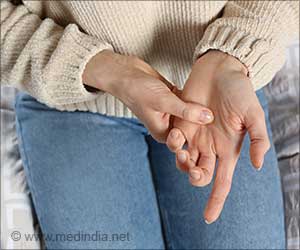Trigger finger happens when repetitive or forceful movements cause inflammation in the tendons connecting muscles to bones.
- Trigger finger, or stenosing tenosynovitis, affects hand tendons causing finger locking and discomfort
- Its symptoms include stiffness, clicking sounds, and tenderness near the affected finger
- Prevention involves proper techniques, gradual engagement in activities, scheduled breaks for repetitive tasks, and ergonomic smartphone use
Trigger Finger
Go to source).
TOP INSIGHT
Trigger finger is more prevalent among women and is notably common in older individuals, but it can affect people of all ages. #socialmedia #toomuchphoneuse #medindia
Know the Symptoms of Trigger Finger
The symptoms of trigger finger can vary in severity and may include:- Morning finger stiffness
- Audible popping or clicking sounds when moving the finger
- Tenderness or the presence of a lump in the palm near the affected finger's base
- Episodes of the finger catching or locking in a bent position, followed by sudden release
- Prolonged bending of the finger
What Triggers a Trigger Finger? Trigger finger often results from repeated or forceful finger and thumb movements, causing inflammation in the tendons that attach muscles to bones. This inflammation can affect the tendon sheath, the protective covering around the tendon, leading to swelling and, in some cases, the formation of scar tissue .
When the inflamed tendon moves within the constricted sheath, it results in a snapping or popping sensation.
Excessive use of mobile phones and scrolling is considered to be one of the most common causes of hand pain, trigger finger is believed to have affected around 2 percent of the world's general population.
Several other factors can contribute to trigger finger, including underlying medical conditions such as diabetes, thyroid disease, gout, and rheumatoid arthritis.
Age also plays a role, with the condition being more common in older individuals. Additionally, it's more prevalent among women.
Treatment Options
The treatment of trigger finger can involve both non-surgical and surgical approaches:Non-Surgical Approach:
- Rest: Allowing the hand to rest and avoiding activities that worsen the condition can aid in recovery
- Splinting: Wearing a splint at night to keep the affected finger or thumb straight during sleep can be beneficial
- Exercises: Gentle stretching exercises for the hands can reduce stiffness and improve range of motion
- Medications: Over-the-counter drugs like paracetamol and nonsteroidal anti-inflammatory drugs may provide relief
- Steroid Injections: Corticosteroid injections into the tendon sheath at the base of the affected digit can reduce inflammation and pain
Surgical Approach:
When non-surgical methods fail to alleviate symptoms, surgical intervention may be necessary, typically in the form of "trigger finger release" surgery.Preventing the Trigger Finger
Preventing trigger finger involves minimizing strain on the hands, fingers, and thumbs:- Proper Techniques: Learn correct hand postures and techniques for sports and work-related activities to reduce the risk of trigger finger
- Gradual Engagement: When starting new exercises or activities, take a gradual approach to minimize the risk of injury
- Scheduled Breaks: If engaged in repetitive tasks that strain the hands, take regular breaks to reduce stress
- Ergonomic Smartphone Use: Adopt ergonomic smartphone practices to reduce finger strain. Hold devices in a way that minimizes stress and avoid extended periods of texting or typing
Reference:
- Trigger Finger - (https://www.assh.org/handcare/condition/trigger-finger)
Source-Medindia
 MEDINDIA
MEDINDIA




 Email
Email






